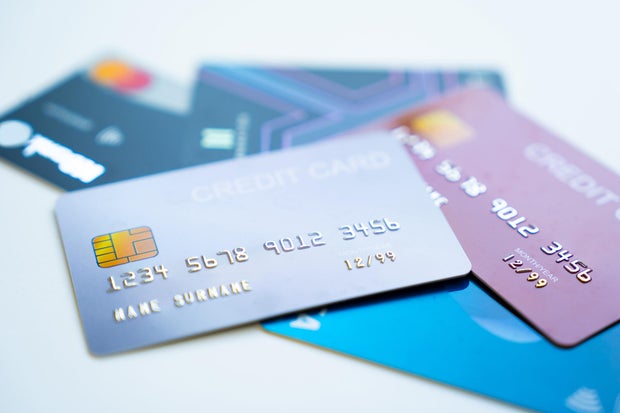Getty Images
It’s no secret that credit card debt has been weighing heavily on household budgets lately. With average interest rates hovering around 22% and cardholder balances averaging nearly $8,000, it can be hard to get control of this type of debt, especially once the compound interest charges start accruing. As a result, finding a way to lower those costs may be a high priority on your list. Luckily, there are multiple tools you can use to help manage and potentially eliminate that debt faster, including balance transfer credit cards, personal loans and home equity lines of credit (HELOCs).
On the surface, these three options might seem similar. After all, every one of these options allows you to consolidate your debt into one product with a single monthly payment obligation, and with each option, you could potentially pay less in interest. But these borrowing tools differ in a range of ways, including how they work, the requirements for getting approved and the risks you take on. And, finding the right one could be the difference between paying off your debt sooner or winding up in a more difficult financial situation down the road.
With interest rates still elevated across lending products, though, the decision isn’t as simple as picking the lowest-rate option. Factors like your credit score, income stability, home equity and payoff timeline all play major roles, so you’ll need to do your research to choose the best fit for your financial situation.
Learn more about the debt relief help that’s available to you today.
Balance transfer vs. personal loan vs. HELOC: Which works for credit card debt?
When comparing these options, it’s important to understand their mechanics, costs and potential drawbacks. Here’s what to know about the potential benefits and downsides of each option:
Balance transfers
Balance transfers involve moving your existing credit card debt to a new card, typically one offering a promotional 0% interest rate that lasts from 12 to 21 months, on average. During this zero-interest period, every payment you make goes directly toward the principal, potentially saving you thousands of dollars in interest charges. The process is relatively straightforward, and you can often complete balance transfers online within minutes.
However, balance transfers aren’t a magic bullet. Most cards charge a transfer fee of 3% to 5% of the amount you’re transferring, which can add hundreds of dollars to your debt before you even start. More importantly, though, that promotional rate is temporary. When it expires, the interest rate jumps to the card’s standard rate, which might be just as high as what you started with. You’ll also need good credit to qualify for the best offers, and the credit limit on your new card might not cover all your existing debt.
Find out how you may be able to settle your debt for less than what you owe.
Personal loans
Personal loans offer a different approach entirely. Instead of shuffling debt between credit cards, you’re taking out an installment loan with fixed monthly payments over a set period, which can vary but is typically between two and seven years. This creates a clear end date for your debt and avoids the risk that comes with borrowing at a variable interest rate. Since personal loans are unsecured, you won’t risk losing collateral if you can’t make payments, either.
The trade-off is that personal loan interest rates are usually higher than what you’d get with a home equity product, especially if your credit score has taken hits from carrying high balances. Personal loan rates are averaging about 12.5% currently, but can be two to three times higher for those with poor credit. Unlike balance transfer credit cards, there’s no promotional period either, so you’ll start paying interest immediately. You’ll also need to qualify to borrow based on your current income and credit profile.
HELOCs
With a HELOC, you’re essentially tapping into a portion of your home equity and getting a low-rate line of credit you can use to consolidate your debt in return. HELOCs function like credit cards, meaning that you can borrow, repay and borrow again up to your credit limit during the draw period, and this borrowing tool typically comes with the lowest interest rates of the three options (compared to the regular balance transfer card rate) because your home secures the debt. That, in turn, can help you save a lot of money on interest charges, and the high average credit limits HELOCs come with make this option a smart one for those with hefty amounts of debt.
The obvious downside, though, is putting your home on the line to consolidate your debt. If you can’t make the payments on your line of credit, you could face foreclosure. It’s important to understand that there’s a lot more variability in HELOC terms than traditional purchase and refinance mortgages. While some fixed-rate HELOCs are available, most come with variable interest rates, meaning your payments could increase if rates rise in the future. There are also typically closing costs involved, and the application process resembles getting a mortgage. Some lenders require traditional appraisals while others don’t, but all HELOC lenders will require extensive documentation of your income, assets and employment. Some lenders also require you to maintain a minimum balance or pay annual fees.
How to decide which option works best for you
The right choice between these options depends on a combination of your financial profile, debt amount and repayment timeline. If you have excellent credit and a smaller balance that you can realistically pay off in 12 to 21 months, a balance transfer card can save you the most in interest. If you need a more structured repayment plan or have a larger balance, a personal loan might be a better fit. And if you have substantial home equity, a HELOC can offer low rates and flexibility, provided you’re comfortable with the risk of putting your home on the line.
You should also consider your credit score, as it impacts both your chances of being approved and the interest rate you’ll receive. The size of your debt matters, too. Smaller balances can be easier to handle with a balance transfer, while larger amounts may require the structure of a personal loan or the capacity of a HELOC. The fees and total borrowing costs should also be factored into your decision, not just the advertised interest rate. Running the numbers for each option can help you make an informed choice.
The bottom line
Balance transfers, personal loans and HELOCs all have the potential to lower the cost of credit card debt, but the best choice for you will depend on your circumstances, goals and comfort with risk. The key is to use whichever tool you choose strategically and to pair it with habits that prevent you from running up new debt. By weighing the pros and cons of each option carefully and aligning your choice with your financial reality, you can create a repayment plan that moves you closer to a debt-free future.










